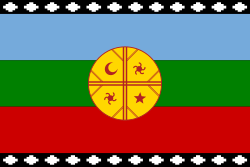Battle of the Maule
| Battle of the Maule | |||||||
|---|---|---|---|---|---|---|---|
| Part of the Inca Empire wars of conquest | |||||||
Huamán Poma de Ayala's picture about the confrontation between the Mapuches (left) and the Incas (right) | |||||||
| |||||||
| Belligerents | |||||||
| Inca Empire | Mapuches, Purumaucas and their Antalli, Pincu, and Cauqui allies | ||||||
| Commanders and leaders | |||||||
|
Emperor Túpac Yupanqui General Sinchiruca |
War chief Kurillanka War chief Warakulen War chief Lonkomilla War chief Futahue War chief Yankinao | ||||||
| Strength | |||||||
| 20,000[1] | 18,000 - 20,000 | ||||||
| Casualties and losses | |||||||
| Numerous | Numerous | ||||||
The Battle of the Maule was fought between the Mapuche people of Chile and the Inca Empire of Peru in what is now the Maule River, Chile. The three-day battle, which is generally believed to have occurred in the reign of Tupac Inca Yupanqui (1471-93 CE),[2] marked the end of the Incas' southward expansion.
In a six-year campaign with an army that eventually rose to 50,000 men, the Inca general Sinchiruca[3] had subdued the regions of northern Chile, Copiapó, Coquimbo, Aconcagua and the Maipo Valley around what is now Santiago. After securing the Maipo Valley Sinchiruca sent 20,000 men down to the valley of the Maule River. The territory of the Picunche people inhabiting this last region south of Maipo Valley extended further to the south to the Itata River and these people the south of the Maipo Valley had refused to submit to the rule of the Inca and called on their allies south of the Maule; the Antalli, Pincu, and Cauqui to join in opposing these invaders.[4] This defiance gave them their distinctive name of Purumaucas from the quechua puruma auca meaning those not under the rule of the Inca. The Spanish later corrupted the name into Promaucaes.
The Incas crossed the Maule River, and keeping their old custom, they sent messengers to require these Purumaucas to submit to the rule of the Inca or resort to arms. The Purumaucas had determined to die before losing their freedom, and responded that the victors would be masters of the defeated and that the Incas would quickly see how the Purumaucas obeyed. Three or four days after this answer, the Purumaucas and their allies arrived and camped in front of the Incas' camp with 18,000 - 20,000 warriors. The Incas tried diplomacy, offering peace and friendship, claiming they were not going to take their land and property but to give them a way to live as men. The Purumaucas responded saying that they came not to waste time in vain words and reasoning, but to fight until they won or died. The Incas promised battle the next day.[4]
The following day both armies left their camps and fought all day without either gaining an advantage, and both suffering many wounded and dead. At night they both retired to their positions. On the second and third day they fought with the same results. At the end of the third day of battle both factions saw that they had lost more than half their number in dead, and the living were almost all wounded. On the fourth day, neither side left their own camp, which had been fortified, as they hoped to defend them if their opponents attacked. The fifth and sixth days were passed in the same manner but by the seventh the Purumaucas and their allies retired and returned home claiming victory.[1][5]
Notes
- 1 2 Thomas Carlyle " Fraser's magazine for town and country , Vol 30" page 43
- ↑ The history of the Inca campaign in Chile and this battle are known from the Comentarios reales of de Inca Garcilaso de la Vega, Segunda Parte : Libro VII Cap. 18, 19 and 20. These were derived from Inca sources. The Spanish histories of Jerónimo de Vivar, Crónica y relación copiosa y verdadera de los reinos de Chile and Vicente Carvallo y Goyeneche, Descripción Histórico Geografía del Reino de Chile, Tomo I, Capítulo I mention it also.
- ↑ Vicente Carvallo, Comentarios reales, Segunda Parte : Libro VII Cap 18
- 1 2 de Inca Garcilaso de la Vega, Comentarios reales Segunda Parte : Libro VII Cap 19
- ↑ de Inca Garcilaso de la Vega, Comentarios reales Segunda Parte : Libro VII Cap 20
Sources
- Inca Garcilaso de la Vega, Comentarios reales, Segunda Parte : Libro VII, Cap. 18, 19, 20.
- Jerónimo de Vivar, Crónica y relación copiosa y verdadera de los reinos de Chile (Chronicle and abundant and true relation of the kingdoms of Chile) ARTEHISTORIA REVISTA DIGITAL; Crónicas de América (on line in Spanish)
- Vicente Carvallo y Goyeneche, Descripcion Histórico Geografía del Reino de Chile (Description Historical Geography of the Kingdom of Chile), PDF E Libros from Memoria Chilena (History of Chile 1542-1788)
Coordinates: 35°34′10.36″S 71°41′53.95″W / 35.5695444°S 71.6983194°W
